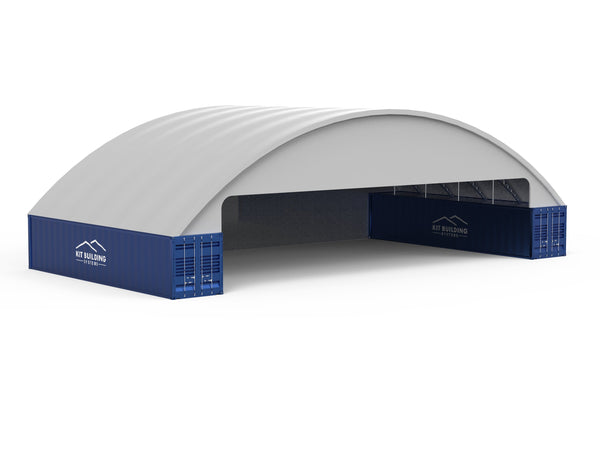Article: Why Agricultural Buildings are Crucial for Modern Farming Success
Why Agricultural Buildings are Crucial for Modern Farming Success
For many people, farming means seeing big fields lit up by golden sunlight, hearing cows mooing softly, and smelling the clean smell of freshly cultivated soil. But beneath this beautiful scenery is an arrangement of necessary infrastructure—agricultural buildings—that is missing from some views but is essential for every farm to succeed.

These buildings serve as the cornerstone for agricultural operations, enabling effective practices, ideal for greenhouses and nurseries, and food security. They are more than just shelters. Let's examine these 5 main factors in more detail to see why agricultural buildings are essential to a successful farm.
- Defence and Preserving:
One's worst enemy as a farmer can be the weather. Agricultural structures serve as the first line of defense for crops, livestock, and equipment from harsh weather conditions such as howling winds, bitter frost, and blistering summer sun.
Protecting Crops: To avoid spoiling, harvested fruits and vegetables need special grain storage buildings. Silos and warehouses keep an environment under control, shielding crops from hazardous pests, extreme moisture, and temperature swings. Farmers may efficiently manage their harvest by extending the shelf life of products and ensuring minimal loss through proper storage.
Sheltering Livestock: In order to survive, animals require a secure and cozy space. Stables, coops, and barns shield animals from inclement weather, preventing heat exhaustion, hypothermia, and injury from hail and high winds. Proper ventilation and well-designed structures also aid in preventing the spread of illness, enhancing the health and welfare of animals.
Equipment Safety: Investing in modern agricultural equipment is a big deal. For practical farming, tractors, harvesters, planters, and other machinery are necessary. Sheds and workshops, among other agricultural buildings, provide safe storage, protect machinery from the weather, and avoid rust, corrosion, and weather-related damage. This lowers repair expenses and increases the longevity of priceless machinery.
- Logistics and Storage:
Meticulous planning and organization are essential for a successful farm enterprise. Agricultural buildings are necessary for storing goods, maintaining resource flow, and increasing output.
Inventory management: Supplies such as gasoline, fertilizers, seeds, and animal feed are necessary for daily operations. These goods remain arranged and easily accessible when kept in designated storage areas such as barns, sheds, or silos. This promotes effective inventory control, enabling farmers to prevent delays and guarantee a consistent flow of supplies.
Seasonal Needs: The agricultural cycle determines when activities should peak and when they should decrease. Large crops must be held during harvest in structures like granaries and cold storage facilities until they are processed or brought to markets. On the other hand, off-season months can be used in specified workshops for equipment maintenance and repairs, guaranteeing that machinery is ready for the upcoming season.
Transportation Hubs: A few agricultural buildings, such as packing sheds and loading docks, are essential links in the supply chain. These structures make loading and transporting crops to markets easier, quickly, and efficiently, reducing damage while en route and speeding up delivery.
- Supporting Livestock Care:
With the correct infrastructure, livestock housing thrives. Agricultural buildings significantly impact animals' general well-being, productivity, and health.
Specialized Housing: Every animal has different requirements. Nesting boxes and adequate ventilation are features of poultry homes for hens. Comfortable stalls and milking parlors are features of dairy barns. These unique constructions guarantee the comfort and welfare of every kind of animal, promoting the best possible development and output.
Controlled Environments: Some animals, such as young calves or chickens, need specific temperature and humidity levels during the brooding season. These ideal conditions, supplied by specialized structures outfitted with HVAC, ventilation, and lighting systems, guarantee juvenile animals' survival and healthy growth.
Preserving Sanitation: In farm animals, disease prevention is crucial. Devoted structures with effective waste management and drainage systems encourage hygiene and reduce the chance that illnesses may spread among animals.
- Encouraging Value Addition and Processing:
Agriculture in the modern day involves more than just rearing livestock and crops. Farmers can increase profitability by adding value to their raw produce through agricultural storage.
On-Farm Processing: Producers can turn raw resources into completed goods like cheese, yogurt, jams, or pickles using facilities like milking parlors and fruit and vegetable processing machines. Adding value can enhance their earnings and take a more significant portion of the market value.
Packing & Packaging: Proper packing and packaging are essential to increase the shelf life of produce and reduce damage during transportation. Agricultural buildings might have specific areas for these activities, guaranteeing that the products arrive at the customer in the best possible shape.
Value-Added Product Storage: Processed commodities must be appropriately stored before being sent to market. Cheese, yogurt, and jams can be stored in temperature-controlled spaces within agricultural buildings to preserve their freshness and quality until sold.
- Promoting Sustainability and Environmental Responsibility:
The importance of sustainable agriculture techniques is rising. Agricultural structures with good design can make a big difference in environmental responsibility.
Waste Management: Livestock manure has the potential to emit pollutants. Reducing environmental effects is possible by converting waste into renewable energy sources in buildings equipped with biogas digesters and appropriate manure storage facilities.
Water Conservation: There is an increasing concern about water scarcity. Farmers can preserve this valuable resource by utilizing buildings that have water-efficient irrigation systems or rainwater collection systems.
Use of Resources Responsibly: Building designs and energy-efficient building materials can reduce the environmental impact of agricultural operations. Buildings can also contain sustainable energy sources, such as solar panels, lessening fossil fuel dependency.
The Final Word
The unsung heroes of the agriculture industry are the agricultural buildings. They are the cornerstone for effective, fruitful, and sustainable farming methods rather than merely serving as shelters. Agricultural buildings are essential for maintaining food security for the world's expanding population because they offer protection, facilitate effective resource management, advance animal welfare, and promote technological integration. The functionality and design of these structures will change along with agricultural methods, guaranteeing their continuous significance in the dynamic field of agriculture.


